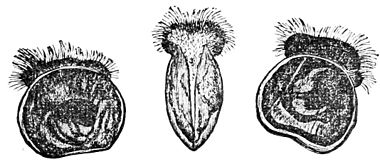young—perhaps, remotely, a sort of fluid amnion. Our bivalve, however, does not spawn after the manner of mollusks generally. It is in its own way viviparous. It does not emit eggs; but, at the proper time, sends forth its young alive. The eggs are dislodged from the ovaries, and committed to the nursing care of the gill and mantel. At first, each egg seems to he inclosed in a capsule. It is of a yellowish color; but, as incubation or development progresses, the color changes, first to a gray, then to a brown, afterward to a violet. This is a sign that the time of eviction is at hand; for Nature now issues her writ to that effect. And wonderful little beings they are when the writ arrives to vacate the homestead; for whole troops of them can go gracefully, and without jostling, through the maziest evolutions in that tiniest sphere—a drop of water. As cited by F. W. Fellowes, in the American Naturalist, says M. Davaine: "Nothing is more curious than to see, under the microscope, these little mollusks travel in a drop of water, in vast numbers, mutually avoiding one another, crossing each other's track in every direction, with a wonderful rapidity, never touching, and never meeting." The parent-oyster has, indeed, a prodigious family to turn out upon the world. But when this time does come, though winter be near, her actions are summary, and the wee bairns are every one ordered from home. They are spit forth, or ejected from the shell. Filled with water, the valves are suddenly snapped together. Every snap emits a small, whitish cloud. Though a little of the milky fluid be in it, this whitish cloud is composed chiefly of the tiny fry; for, individually, they are almost invisible. Indeed, who shall count the oyster's offspring? Science, by her own methods,

Fig. 2.—The Spat.—Oysters just born, highly magnified.
has made the computation; and so she gives us the astounding assurance that a single oyster, during one spawning-season, emits two million embryos! Each one, though scarcely larger than a pin-point, is a lively little affair; and such an odd little fellow, too! In fact, it has scarcely any resemblance to its parent, either in external form or internal anatomy; while, in habit, it differs as widely as does the flying bird from the burrowing mole. Let us look a moment at Fig. 2. These are young oysters just sent into the world. They are not so large, by a good deal, as an ordinary pin's-head. How angular the shell is! And the internal organization is, as yet, very simple. And

